Health and social care staff experience: report 2019
Independent report by Webropol providing detailed information and analysis of staff experience in Health and Social Care.
Action Plans
The chart below shows the percentage of teams who completed an Action Plan within the 12 week requirement2. The 5 Boards with the highest percentage of teams with Action Plans are all National Boards. NHS Lanarkshire is the Geographic Board with the highest percentage of teams with Action Plans (77%). NHS Western Isles stands out in this analysis with only 13% of teams producing Action Plans, some 28 percentage points below any other Board.
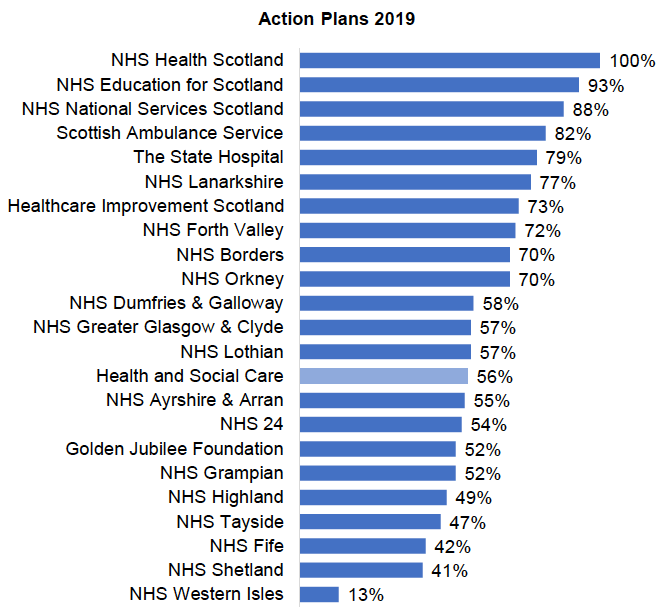
2 Some Action Plans are completed after the 12 week deadline. These are not included in the reported percentages of Action Plans completed
Percentage of Teams with Action Plans comparison over time
Across Health and Social Care 58% of teams have completed Action Plans within 12 weeks in 2019. This is an increase of 2 percentage points on 2018 and 15 percentage points on 2017.
| 2017 | 2018 | 2019 | Change from 2018 to 2019 (pp) | Change from 2017 to 2019 (pp) | |
|---|---|---|---|---|---|
| Health and Social Care | 43% | 56% | 58% | 2 | 15 |
| Golden Jubilee Foundation | 63% | 71% | 52% | -19 | -11 |
| Healthcare Improvement Scotland | 72% | 89% | 73% | -16 | 1 |
| NHS 24 | 14% | 66% | 54% | -12 | 40 |
| NHS Ayrshire & Arran | 54% | 60% | 55% | -5 | 1 |
| NHS Borders | 26% | 75% | 70% | -5 | 44 |
| NHS Dumfries & Galloway | 13% | 46% | 58% | 12 | 45 |
| NHS Education for Scotland | 73% | 82% | 93% | 11 | 20 |
| NHS Fife | 40% | 42% | 42% | 0 | 2 |
| NHS Forth Valley | 26% | 80% | 72% | -8 | 46 |
| NHS Grampian | 54% | 49% | 52% | 3 | -2 |
| NHS Greater Glasgow & Clyde | 44% | 50% | 57% | 7 | 13 |
| NHS Health Scotland | 94% | 90% | 100% | 10 | 6 |
| NHS Highland | 29% | 48% | 49% | 1 | 20 |
| NHS Lanarkshire | 48% | 67% | 77% | 10 | 29 |
| NHS Lothian | 33% | 60% | 57% | -3 | 24 |
| NHS National Services Scotland | 78% | 76% | 88% | 12 | 10 |
| NHS Orkney | 81% | 81% | 70% | -11 | -11 |
| NHS Shetland | 14% | 45% | 41% | -4 | 27 |
| NHS Tayside | 39% | 41% | 47% | 6 | 8 |
| NHS Western Isles | 12% | 14% | 13% | -1 | 1 |
| Scottish Ambulance Service | 72% | 86% | 82% | -4 | 10 |
| The State Hospital | 78% | 55% | 79% | 24 | 1 |
In 2019 10 Boards have increased the percentage of teams with Action Plans from 2018. The biggest increase is in The State Hospital with 79% of teams completing Action Plans in 2019, compared to 55% in 2018. The biggest decrease in the percentage of teams with Action Plans in 2019 from 2018 is in Golden Jubilee Foundation, down 19 percentage points form 71% in 2018 to 52% in 2019.
Following the increase from 14% in 2017 to 66% in 2018, NHS 24 dropped back to 54% Action Plan completion in 2019. Through 2019 the Board was delivering two significant strategic priorities alongside iMatter questionnaire and action plan completion, which they believe may have contributed to the decrease in response rate and completed action plans.
Notes:
1. The NHS Ayrshire and Arran 2018 No Report percentage was amended following the 2018 report publication from 60% to 61%”
2. Following removal of Chair Teams from the 2017 data, the No Report percentages for 11 Boards have changed from those reported in 2018
Looking at longer term progress from 2017 to 2019, all but three Boards have increased the percentage of teams with completed Action Plans. The largest increase is in NHS Dumfries and Galloway, having gone from 13% in 2017, 46% in 2018 to 58% in 2019, an overall increase of 45 percentage points over the three years. NHS Lanarkshire has also achieved large increases each year in the percentage of teams with Action Plans. Below are summaries of actions taken by these Boards:
Case Study 9: NHS Dumfries and Galloway – Increasing the percentage of teams with Action Plans
NHS Dumfries and Galloway have continued staff awareness session in 2019, with a focus on how to effectively action plan – particularly highlighting that small actions matter, small changes, not service changing.
Clear and easy-to-action communications have been created, including weekly all staff emails encouraging Action Plan completion.
The campaign has successfully led to a continued increase in Action Plan completion again in 2019.
Case Story 10: NHS Lanarkshire – Increasing the percentage of teams with Action Plans
“Local champions, supported by the Op Lead and Board Administrator, are in place in each directorate / partnership area and have been key this year in recognising where support is required working with the managers ensuring they had the time and support to take things forward, asking for additional support from Op Lead if required. The impact of this was very noticeable within our Acute area where, although the overall response was below 60%, there was a big rise in action plans completed – the local champions put in place here were at Assistant Service Manager level and able ensure robust support was provided in pressure areas.”
As Op Lead I keep in touch with managers and local champions during their 12 week action plan widow offering 1:1 or group support if required.”
The Team Story below illustrates the pride in ensuring all HSCP teams complete an action plan:
The STARS service are the first in this Board to have every team complete a 2019-20 Action Plan, a significant achievement for a geographically dispersed team. The visual created to illustrate the Team story is both a recognition of the value of iMatter and an insight into the positive culture it is supporting.
NHS Dumfries and Galloway, HSCP Team - Short Term Reablement Service (STARS) – Striving for excellence in care
Relationship between Action Plan Percentage and other KPIs
Using the KPI data for each Board we can explore the relationship between the percentage of teams with Action Plans and each of the other KPIs:
| Board | Response Rate | EEI | No Report* | Action Plans |
|---|---|---|---|---|
| Health & Social Care | 62% | 76 | 34% | 58% |
| Golden Jubilee Foundation | 67% | 77 | 29% | 52% |
| Healthcare Improvement Scotland | 90% | 78 | 19% | 73% |
| NHS 24 | 65% | 78 | 43% | 54% |
| NHS Ayrshire & Arran | 60% | 76 | 34% | 55% |
| NHS Borders | 53% | No Report | 47% | 70% |
| NHS Dumfries & Galloway | 66% | 74 | 25% | 58% |
| NHS Education for Scotland | 87% | 82 | 10% | 93% |
| NHS Fife | 62% | 76 | 36% | 42% |
| NHS Forth Valley | 68% | 75 | 26% | 72% |
| NHS Grampian | 62% | 77 | 35% | 52% |
| NHS Greater Glasgow & Clyde | 59% | No Report | 37% | 57% |
| NHS Health Scotland | 93% | 81 | 0% | 100% |
| NHS Highland | 60% | 74 | 37% | 49% |
| NHS Lanarkshire | 65% | 79 | 30% | 77% |
| NHS Lothian | 63% | 77 | 34% | 57% |
| NHS National Services Scotland | 82% | 76 | 13% | 88% |
| NHS Orkney | 66% | 75 | 30% | 70% |
| NHS Shetland | 63% | 78 | 33% | 41% |
| NHS Tayside | 61% | 75 | 38% | 47% |
| NHS Western Isles | 56% | No Report | 43% | 13% |
| Scottish Ambulance Service | 59% | No Report | 42% | 62% |
| The State Hospital | 79% | 77 | 8% | 79% |
Relationship between Action Plan Percentage and Response Rate
The chart below shows the response rate and the percentage of teams completing an Action Plan for each Board. This suggests some positive relationship between the two measures as Boards with high response rates are most likely to have a high Action Plan completion. The three Boards with both the highest response rate and the highest percentage of Action plans are National Boards.

Whilst NHS Borders had the lowest response rate (53%) it has a good percentage of teams with Action Plans completed (70%). Similarly, the Scottish Ambulance Service only achieved a 59% response rate but has the fourth highest percentage of teams with Action Plans (82%).
Relationship between Action Plan Percentage and EEI
Comparing the percentage of teams with Action Plans and the EEI for each Board that received a report, the relationship is less strong, with examples of Boards such as
- NHS National Services Scotland having the third highest percentage of completed Action Plans, but an EEI score of 76.
- NHS Shetland with an EEI score of 78, but only 41% of teams with completed Action Plans.
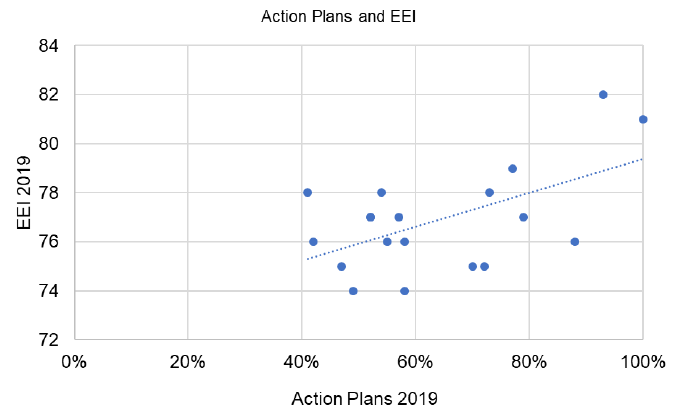
Relationship between Action Plan Percentage and No Report
As might be expected there is an inverse relationship between the percentage of teams with Action Plans and the percentage with No Report. There are some exceptions, for example NHS Borders, where 47% of teams did not get a report but still 70% of teams completed an Action Plan. The case study below illustrates the proactive steps taken by NHS Borders to encourage Action Plan completion.
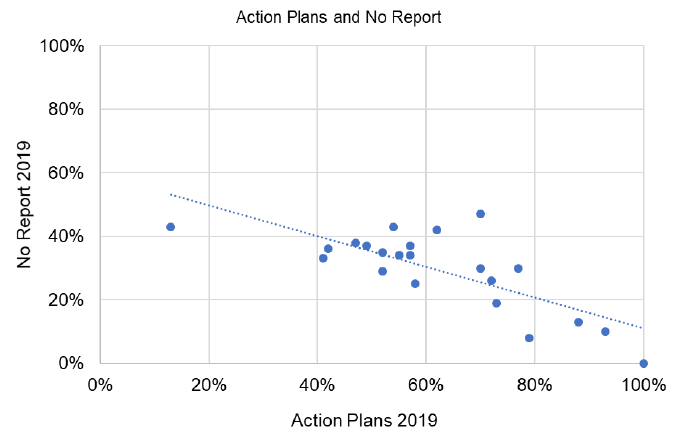
Case Study 11: NHS Borders – Encouraging Action Plan Completion
“Within NHS Borders we are very clear with managers and their teams that whilst completing the survey is voluntary, there is an expectation that each team will submit an action plan.
In 2018 our HR Business Partners provided a great deal of support to services within their area to encourage them to complete an action plan. In 2019 we deliberately took a step back from this approach because we wanted to encourage ownership for the iMatter process both within a management and team level (although of course support was still available through the iMatter team). Despite this step back, we still had a high action plan conversion rate.”
Summary
The level of Action Plan completion has risen in 2019 to 58% from 56% in 2018. At individual Board level there is considerable variation from 100% in NHS Scotland to only 13% in NHS Western Isles.
There are examples of how Boards have encouraged their teams to develop Action Plans and this is reflected in increased percentages of teams with Action Plans in many Boards. However, there are a number of Boards that have notable decreases in the percentage of teams with Action Plans, which warrants further review prior to commencement of the 2020 iMatter programme.
Action Plan Content Analysis
As a Test and Learn project for 2019, automated analysis has been carried out on the text contained in all the Action Plans completed within the 12 week timing. The output of this analysis is presented as Word Clouds in which the size of a word directly corresponds to the number of times a word has been used across all the Action Plans; the larger the word, the more times it appears in the Action Plans. A separate Word Cloud is provided for each of the four sections in the Action Plan template:
- What we do well
- Areas for improvement
- Desired Outcome
- Action
This process of analysis counts the number of times a word is used across all Action Plans. The system incorporates ‘stemming’ whereby words that are similar are grouped together. For example; Manager, Management, Managerial etc. will all be grouped and shown collectively as ‘Management’. Similarly, Communicate, Communication, Communications are grouped and shown collectively as ‘Communication’.
As this analysis is automated and is based on single words it gives an indication of the topics that are covered in Action Plans. However, it does not give full insight into the themes or the sentiment contained within Action Plans.
What we do well
The most used words in the ‘What we do well’ section are based on ‘team’ and ‘work’. ‘Support’, ‘staff’ and ‘together’ are also used frequently. This suggests an emphasis around how team do (or do not) work well together and how they do (or do not) support each other.
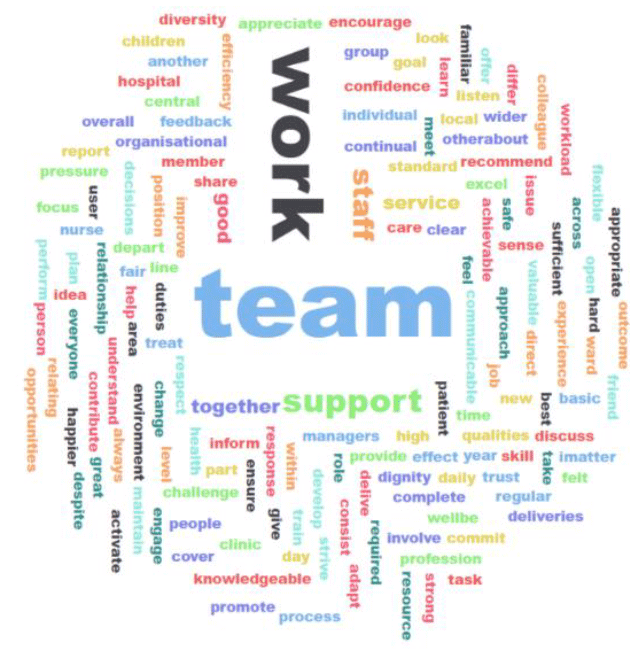
Areas for Improvement
In this section of the Action Plan, words relating to ‘decisions’, ‘communications’ and ‘organisation’ are used more, along with ‘staff’ and ‘team’. This suggests that many Action Plans explore a desire to make decision making and communication as effective as possible within or across teams. This is a topic that is referenced in many of the team stories.
The word ‘involve’ is also used a lot, again reflecting many of the team stories that reference whole team collaboration.
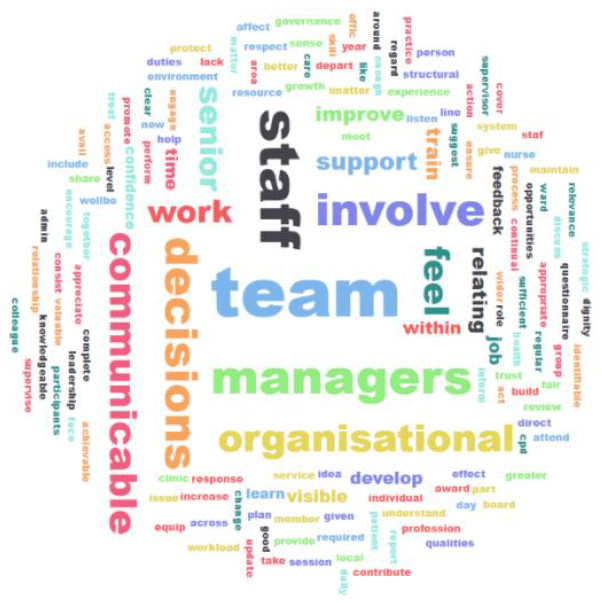
Desired Outcome
Amongst the key words used in the Desired Outcomes section alongside ‘staff’ and ‘team’ is ‘improve’, highlighting the aim of many Action Plans to deliver an improvement in some aspect of the team’s working environment.

Action
It is notable that words stemming from ‘meet’ are most frequently used in the Action section. It is evident from many of the Team Stories that establishing more regular meetings or meetings with more focussed purposes (e.g. getting to know the team or senior management, sharing successes etc.) is at the heart of many of the success stories. Hence the prevalence of ‘meet’ and also ‘regular’ and discuss’ in this section of the Action Plans.
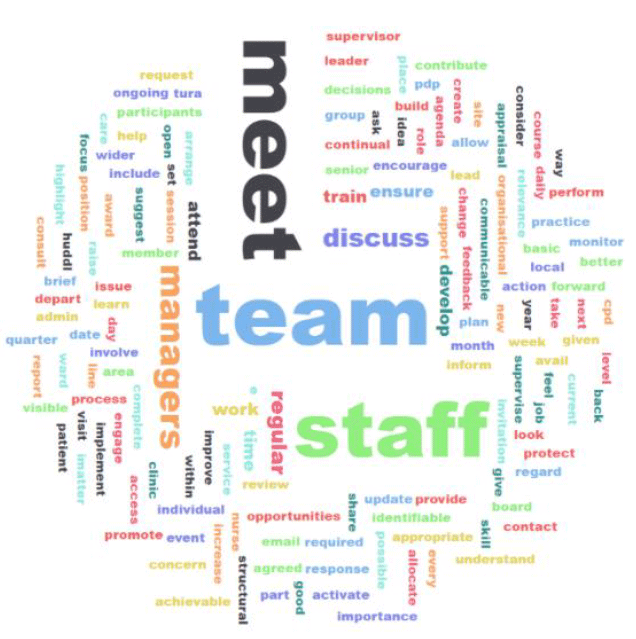
Contact
Email: alison.carmichael@gov.scot
There is a problem
Thanks for your feedback